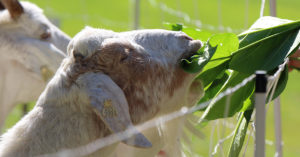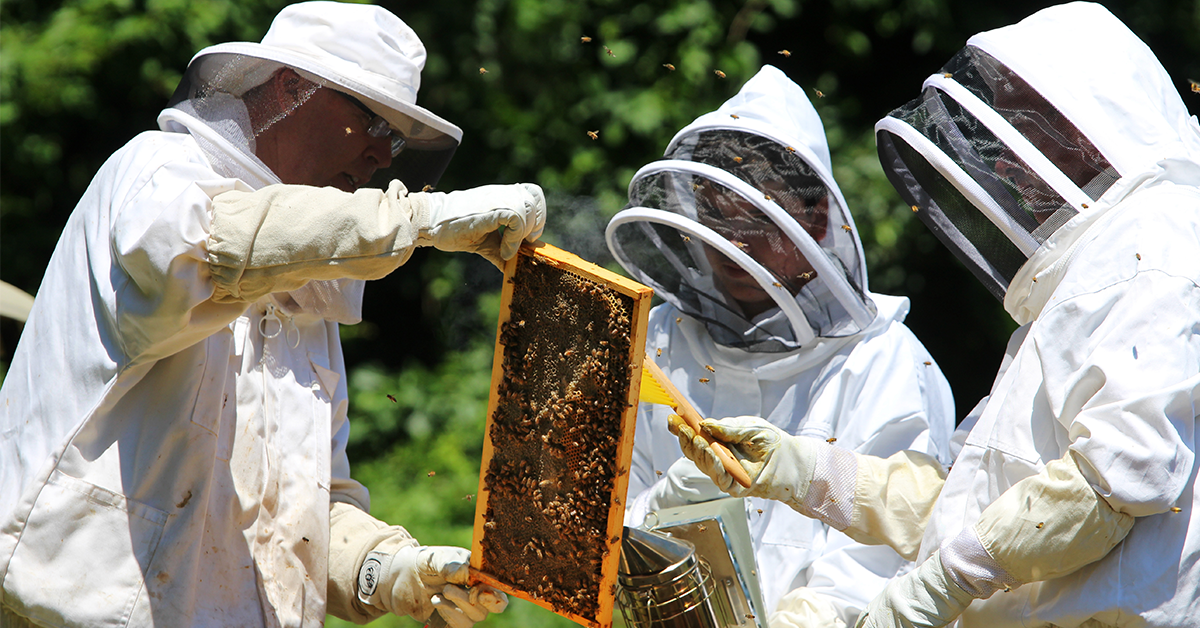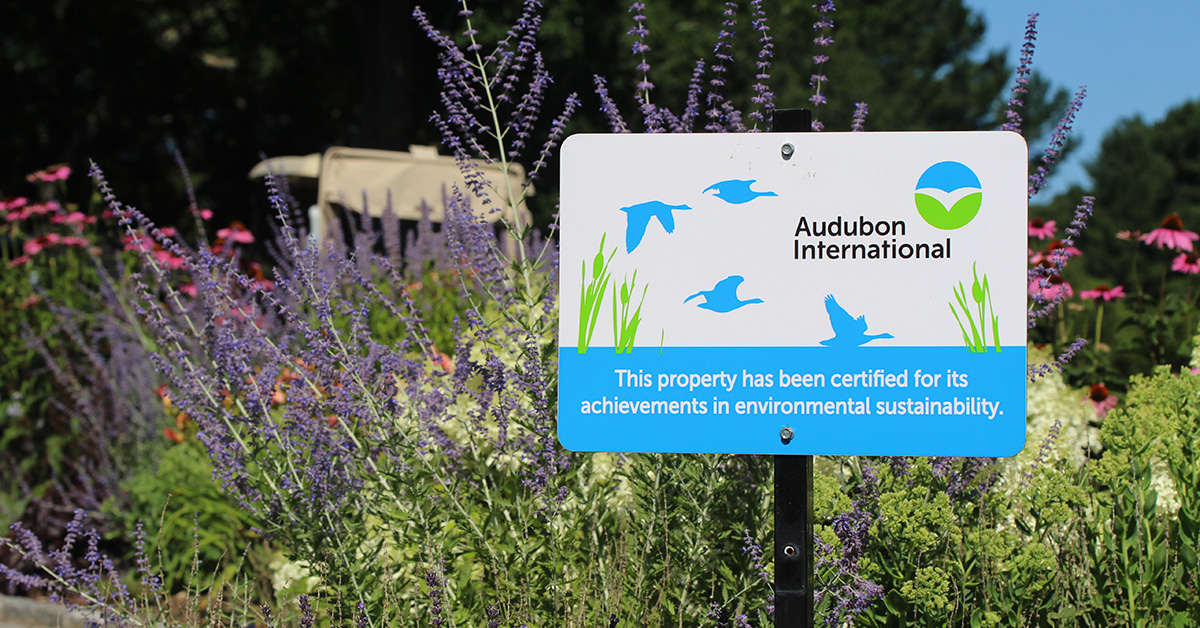NEEDHAM, Massachusetts – When you step onto a golf course, the last thing you might expect to see is a herd of goats — but the animals are a key part of Needham Golf Club’s efforts to improve its sustainability through the Audubon Cooperative Sanctuary Program.
Needham first joined Audubon International in the early 2000s and began to develop a certification plan in 2009, said Superintendent Tim Hood. Certification requires achievement in six categories, which mainly involve reducing the amount of managed turf on the course, improving water quality, becoming more wildlife-friendly, and communicating these changes effectively to golfers.
“While we have to consider all different aspects of the environment and our certain microclimate here, we are focused on the wildlife and the habitat that are on the property,” Hood said. “We also think about the water conservation and quality that goes through the property. We’re also thinking about how we can maintain the course while still giving a good quality golf course for the members and being more sustainable.”
The certification process was a lengthy but rewarding one for the Club. It began with an assessment of the property, including an evaluation of what tree species and types of turf grass were on the course. Hood’s team identified areas where maintenance could be reduced and disruption-free wildlife habitat could be increased, lessening the amount of human impact on the course ecosystem. Water conservation and chemical use reduction were also key factors in the plan.
“We made that plan and then we worked on each category at a time,” Hood said. “We’re a small club with a small staff, so it was a long process for us to do all this work together. But we achieved it a few years later.”
Needham finally received its certification in 2016. Since then, the Club successfully achieved recertification, which is required every three years, in 2019 and earlier this year. Hood said the recertification process motivates him and his team to continue evaluating their practices and ways to grow the amount of native areas on the course.
“Well, you’re always trying to improve,” he said. “So where we had a certain square footage of natural areas, we’ve tried to see, without impacting play too much, how we can increase that area, and we did quite a bit these last couple of years and we’re able to just find areas where play is minimal play and it’s not going to make much of a difference in terms of how it affects the golf.”
Hood also credits the Club’s membership for supporting its efforts to become more sustainable, an essential piece of any course’s ability to successfully implement ACSP requirements.
“They understand that the practices that we put in place are for the benefit of the environment and for the property that we occupy,” he said. “So we’ve had great support from the membership, and they know what we’re trying to achieve.”
Speaking of wildlife, Needham has garnered a reputation for the three goats it keeps throughout various parts of the golf course to help with course maintenance — including one nicknamed “Brady” after former Patriots quarterback Tom Brady.
“The goats are just to maintain the understory of the area,” Hood said. “One reason for golf is it helps air movement. Turf likes air movement, it doesn’t like stagnant air, so we try to keep the air movement going around the grass. So instead of clear-cutting and clearing out with machinery and different products, we have the goats go in there.”
Though there are certain types of plants that the goats cannot consume, which are usually those requiring landscaping, “they’ll eat just about anything,” Hood said.
When a certain area of the course requires maintenance, Hood’s team will transport the goats to the new area. The goats will eat just enough of the plants to trim off excess foliage before moving on to a new section. The plants eventually grow back to their original size, setting the stage for the furry landscapers to circle back in the future.
The Club first began using goats to help with course maintenance in 2016. It decided to bring them on as full-time members of the Needham family soon thereafter, and they’ve played an integral role in course upkeep ever since, Needham Golf Club General Manager Geoffrey Piva said.
Visitors who pass by the 8th fairway are welcome to visit and feed the goats.

A new initiative that Needham began last winter was setting up their own bee box, a practice that has been shown to improve pollination and elevate the diversity and sustainability of the bees’ entire ecosystem. The Club’s bee box is set up near the 9th-hole tee, set away from the fairway and located near a thicket of trees to provide cover from wind gusts.
Since the bee box has been in place for several months, Piva says the Club is now focusing on a new venture — collecting a limited amount of the bees’ honey to share with members.
With the assistance of Atlantic Golf & Turf Co-Owner Scott Mackintosh, Hood and his nephew opened up the bee box to gather honey for the first time last week. The team removed a few comb-covered frames from the box, being careful to leave a majority of the existing honey to the bees, and replaced them with new ones for the bees to begin working on. They then used a honey extractor, a family heirloom of Mackintosh’s, to extract the honey from the combs so it could be jarred.

A key part of ACSP certification is member outreach and education to inform golfers what environmental practices are in place and why they are needed.
Needham has done so by installing signage to alert golfers to the presence of environmentally managed areas throughout the course, such as buffer zones around waterways and areas of brush where small animals tend to reside. The Club also leads annual tours for Needham leadership to keep the town informed of its environmentally focused practices.
However, part of Hood’s planning for the future at Needham involves continuing to expand the Club’s ACSP outreach.
“I think more outreach will be great certainly for people that really do not play golf and don’t understand what we’re trying to do here,” he said.
He also plans to keep raising the Club’s environmental standards and strategizing more ways to better its surrounding environment.
“We’re always just finding other ways of trying to improve in each category,” Hood said. “I’m learning a lot through social media. You learn from a lot of different courses on what they’re doing and you’re learning a lot that way on how you can implement those practices on the golf course.”

Visit MassGolf.org and follow @PlayMassGolf on Facebook, Twitter, and Instagram for the latest information regarding Mass Golf member clubs, competitions and events. To join the conversation, use the hashtag #MassGolf.